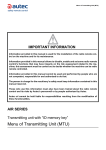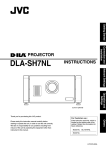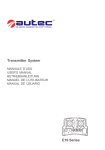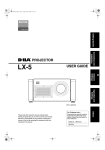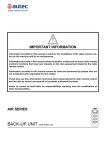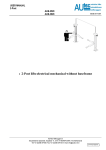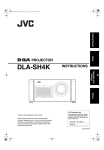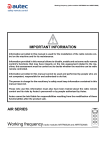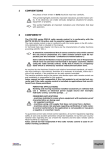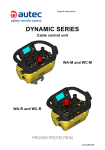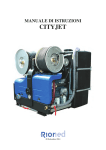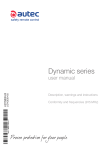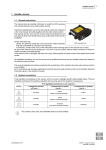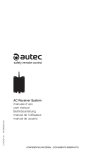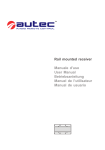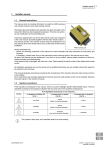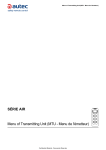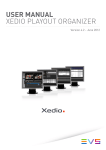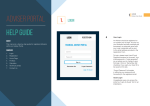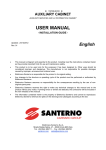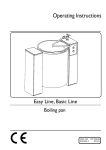Download operation manual
Transcript
English Light Series User manual LILBNAG0-01 1 Introduction to the user manual ............................................................................................... 1.1 General instructions........................................................................................................... 1.2 Conventions....................................................................................................................... 1.3 Documentation................................................................................................................... 2 2 2 2 2 Light series radio remote controls........................................................................................... 2.1 General description............................................................................................................ 2.2 Safety functions ................................................................................................................. 2.3 Conformity ......................................................................................................................... 2.4 Risk analysis...................................................................................................................... 2.5 Working conditions ............................................................................................................ 2.6 General technical data....................................................................................................... 2.7 Identification plates and technical data plates ................................................................... 2.8 Storage .............................................................................................................................. 3 3 3 4 4 5 5 5 6 3 Transmitting unit........................................................................................................................ 3.1 Signals ............................................................................................................................... 3.2 Technical data ................................................................................................................... 3.3 Climatic conditions............................................................................................................. 6 6 6 7 4 Receiving unit ............................................................................................................................ 7 4.1 Technical data ................................................................................................................... 8 4.2 Climatic conditions............................................................................................................. 8 5 Warnings for use........................................................................................................................ 8 6 How the radio remote control works........................................................................................ 9 6.1 Commands ........................................................................................................................ 9 6.2 Recharging the battery .................................................................................................... 10 7 Warnings for installation......................................................................................................... 10 8 Programming............................................................................................................................ 12 8.1 Transmitting module E16STXEU_................................................................................... 12 8.2 Receiving module E16SRXEU_ ...................................................................................... 13 9 Frequencies.............................................................................................................................. 9.1 Manual selection mode.................................................................................................... 9.2 Automatic scan mode ...................................................................................................... 9.3 Manual selection of the working frequency...................................................................... 13 13 14 14 10 Maintenance ............................................................................................................................. 14 10.1 Routine maintenance....................................................................................................... 15 10.2 Special maintenance (AUTEC SERVICE) ....................................................................... 16 11 Diagnostics............................................................................................................................... 16 11.1 Transmitting unit diagnostics ........................................................................................... 17 11.2 Receiving unit diagnostics ............................................................................................... 17 12 Disposal .................................................................................................................................... 18 LILBNAG0-01.fm Page 1 English INDEX 1 INTRODUCTION TO THE USER MANUAL English 1.1 GENERAL INSTRUCTIONS This manual is an integral part of the radio remote control and of its safety functions. This manual shall complete the instructions provided by the producer of the remote controlled machine and/or by those who install the radio remote control on the machine. All radio remote control installation, usage and maintenance operations can only be carried out by qualified technicians who are suitably trained with respect to the relevant norms and laws. The radio remote control owner, installer, user, the person in charge of its maintenance and the responsible for the safety on the workplace where the radio remote control is used must therefore read and understand each part of this manual. As for instructions and warnings regarding the machine where the radio remote control is installed, follow the instructions given in the machine's manual. No part of this manual may be reproduced, in any form or by any means, without written permission of Autec (including recording and photocopying). Always remember that: 1. the documentation must be kept for the whole life of the radio remote control: after reading, keep it on hand for future reference 2. photos in this manual are useful examples that help understand the instructions and warnings of each radio remote control configuration 3. if necessary, contact Autec if any of the instructions and/or warnings given in this manual are not clear 4. if this manual is lost or damaged, ask Autec for a copy. Please specify the serial number of the related radio remote control. 1.2 CONVENTIONS In this manual, all important information is highlighted through the following symbols and conventions: abcd… abcd… : WARNINGS : IMPORTANT TEXTS 1.3 DOCUMENTATION The documentation enclosed with each radio remote control is inside a plastic envelope and consists of: - manual of the radio remote control (one for each language) - EC Declaration of Conformity - guarantee booklet - technical data sheet - guarantee activation code (see label on the plastic envelope). The battery charger package also includes the manual of the battery charger. When purchasing a radio remote control, always make sure that such documents have been supplied: if they are not, please ask for them to Autec specifying the radio remote control serial number. Guarantee booklet The guarantee can be activated in the specific area at www.autecsafety.com. Type the serial number and the radio remote control activation code to register (see label on the plastic envelope containing the documentation). Page 2 LILBNAG0-01.fm Technical data sheet The technical data sheet shows the wiring diagram between the receiving unit and the machine. The technical data sheet must be filled in, checked and kept updated by the installer, who is responsible for correct wiring. Once all necessary checks have been carried out, the installer must undersign the technical data sheet, which must be kept with the radio remote control documentation (always keep a copy of this data sheet for administrative purposes). 2 LIGHT SERIES RADIO REMOTE CONTROLS Autec industrial radio remote controls are used to control machines from a distance, without physical connection between the user and the machine (i.e. wires or connecting cables). Each industrial radio remote control consists of a portable transmitting unit, from which the user can remotely control the machine, and a receiving unit installed on board the machine itself. The transmitting unit, through a radio transmission, sends coded messages that contain commands that will be carried out by the machine. Each message contains an address that is: unique (Autec produces it only once), univocal (specific for each radio remote control) and not reproducible. The receiving unit can only decode the messages coming from its own transmitting unit with the same address. If the radio transmission is disturbed, incorrect or interrupted, the receiving unit autonomously stops the whole system thanks to the passive stop feature. These features of the radio remote control avoid the possibility of an interference from another radio equipment (e.g. a radio remote control) activating any system function. 2.2 SAFETY FUNCTIONS Autec radio remote controls are equipped with some functions that provide high safety levels, in order to safeguard the safety of people and things. Active stop “Active stop” is a command that is activated by the STOP pushbutton (see paragraph 6.1) and is sent by the transmitting unit to the receiving unit in order to immediately stop the machine if the machine needs to be stopped to avoid possible hazards of damage to people and/or properties. This function boosts the machine safety, so that the machine stops in less time than the time needed for stopping with the “passive stop” (see paragraph 2.6). Passive stop The “passive stop” is a function that will cut in should a fault occur during operation. Should the radio link be disturbed, incorrect or interrupted, the receiving unit autonomously and automatically stops the radio remote control features. The cut in time (see paragraph 2.6) of such function can be set (see paragraph 8.2). Protection against unintended movements from the standstill position (UMFS) This safety function protects the system “machine+radio remote control” from unintended movements, namely machine movements not activated intentionally by the user, but resulting from possible electrical and mechanical failure of the radio remote control. Such safety function constantly checks the neutral (rest) position of those actuators that drive the machine's movements. Each time one of those actuators is operated, the transmitting unit sends not only the movement command but also the “SAFETY” movement command. This command activates the SAFETY relay in the receiving unit; such relay must be wired as explained in the wiring instructions LILBNAG0-01.fm Page 3 English 2.1 GENERAL DESCRIPTION provided on the technical data sheet (see paragraph 1.3) and the instructions for correct installation and maintenance (see chapters 7 and 10). 2.3 CONFORMITY Each radio remote control is in conformity with the R&TTE Directive 99/05/CE and its essential safety requirements. Each radio remote control is also in conformity with the standards given in the EC Declaration of Conformity that is enclosed with this manual. The radio remote control shall be used in compliance with the laws and regulations in force in the Country where it is used. In particular, when installing and using the radio remote control, national laws that regulate the following aspects must be respected: - the use and/or possession of a radio remote control - the use of working frequencies that are not yet harmonised in the European countries, that is, frequencies that are not used uniformly within the European Union. Light series radio remote controls can work in the frequency bands 433.05 - 434.79 MHz, 434.04 434.79 MHz and 869.70 - 870.00 MHz in the countries shown in the following table. Austria Belgium Bulgaria Cyprus Czech Republic Denmark Estonia Finland France Germany Greece Hungary Iceland Ireland Italy Latvia Liechtenstein Lithuania Luxembourg Malta Netherlands Norway Poland Portugal Romania Slovakia Slovenia Spain Sweden Switzerland United Kingdom English Limitations & Authorisations 433.05 - 434.79 (MHz) 434.04 - 434.79 (MHz) 869.70 - 870.00 (MHz) • • • • • • • • • • • • • • • • • • • • • • • • • • • • • • • • • • • • • • • • • • • • • • • • • • • • • • • • • • • • • • 2.4 RISK ANALYSIS Autec industrial radio remote controls are intended to be used on hoisting and material handling machines (i.e. cranes, overhead cranes). As provided by the Machinery Directive and its subsequent amendments and additions, when installing the radio remote control the machine producer or those who install the radio remote control on the machine must carry out a specific risk analysis. Such analysis aims at deciding if the machine, for its structural and/or functional features, can be operated by means of a radio remote control system. In particular, the developer and/or the machine producer that plans to equip it with a radio remote control, or the installer of the radio remote control on the machine, are responsible for evaluating if installing a radio remote control may generate risks for the safety of people and/or properties, and shall evaluate in advance whether the machine may be remote controlled. All instructions and warnings provided in this manual must be taken into account when carrying out the risk analysis and when setting out protection measures and safety systems for the controlled machine. The machine producer and/or the person who decides upon radio remote control use and installation is responsible for this analysis. Autec shall not be held liable if this risk analysis is not carried out correctly. Page 4 LILBNAG0-01.fm Forbidden uses Forbidden applications are: - machines installed in areas where equipment with explosion-proof characteristics is required and/or - machines for moving, raising and transporting people. Autec shall not be held liable if the radio remote control is installed on forbidden applications. To guarantee correct radio remote control operation, all current regulations regarding safety at work and accident prevention should be respected. All applicable standards and regulations valid in the user country regarding the use of both the machine and the radio remote control must always be respected. In particular, users of the remote controlled machine must be preventively and properly trained about the use of the machine, the radio remote control and the implemented safety and emergency features. Autec shall not be held liable if the radio remote control is used in working conditions that do not meet the legislative provisions in force in the country where the device is used. 2.6 GENERAL TECHNICAL DATA Frequency band with radio module E16SRXEU1 a....................................... 434.04 - 434.79 MHz .................................................................................................................. or 433.05 - 434.79 MHz Frequency band with radio module E16SRXEU2 ......................................... 869.70 - 870.00 MHz Available radio channels ........................................................................ 16 (434.04 - 434.79 MHz) ............................................................................................................... 32 (433.05 - 434.79 MHz) ............................................................................................................... 12 (869.70 - 870.00 MHz) Channel spacing ................................................................................................................. 25 kHz Hamming distance ..................................................................................................................... ≥ 8 Probability of undetected error ...................................................................................... <10 exp-11 Typical working range ............................................................................................................. 50 m Command response time ................................................................................................. ~ 100 ms Active stop timeb .............................................................................................................. ~ 100 ms Passive stop timec ............................................................................................................. 0.35/1 s STOP protection (according to the EN 954-1) ...................................................................... Cat. 3 a. See paragraph 2.3 to select the permitted working band and chapter 8 if setting is necessary. b. Valid when the radio link between transmitting and receiving unit is not disturbed. c. Refer to paragraph 8.2, DIP No. 1 settings. Due to the characteristics of radio propagation (i.e.: EM interferences, near out-of-range condition), a delay up to one second may occasionally occur from the moment a command in the transmitting unit is released to the moment its corresponding output in the receiving unit is deactivated. Those who decide upon the installation of the radio remote control must make sure that this delay never leads to a dangerous situation in the specific uses. 2.7 IDENTIFICATION PLATES AND TECHNICAL DATA PLATES Autec radio remote controls' identification and approval data are given on plates that are on both the transmitting unit and the receiving unit. These plates must not be: - removed from their position (removal will invalidate the guarantee) - altered or damaged (contact Autec for replacement). LILBNAG0-01.fm Page 5 English 2.5 WORKING CONDITIONS 2.8 STORAGE Radio remote controls must be stored inside their original packing until they are installed on the machine. Environmental storage conditions are given in the relevant table (see paragraphs 3.3 and 4.2). 3 TRANSMITTING UNIT The number of pushbuttons in the LK transmitting unit varies depending on its configuration. English D C E F G B A starting keyswitch E technical data plate B Signalling LED F START pushbutton C pushbuttons G identification plate (in the battery housing) D STOP pushbutton H battery H A 3.1 SIGNALS LED (B) switched off a single blinking MEANING transmitting unit switched off or not started actuator inserted during start up slow blinking transmitting unit is started fast blinking low battery: the transmitting unit switches off 3.5 minutes after the LED starts blinking fast 3.2 TECHNICAL DATA Power supply (battery pack MBM06MH)a................................................................. NiMH 2.4 Vdc Antenna .............................................................................................................................. internal Transmitting power (frequency band 433.05 - 434.79 MHz) ................................... ≤ 10 mW ERP Transmitting power (frequency band 869.70 - 870.00 MHz) ..................................... ≤ 5 mW ERP Housing....................................................................................................................PA 66 (50% fg) Protection degree .....................................................................................................................IP65 Dimensions ......................................................................................................... 80 x 185 x 43 mm Weight .................................................................................................................................... 420 g Battery capacity with fully charged battery (at 20°C) ............................................................ > 12 h "Low battery" warningb ....................................................................................................... 3.5 min a. Refer to battery technical data in the battery charger manual. b. Refer to paragraph 8.1, DIP No. 2 setting. Page 6 LILBNAG0-01.fm 4 TEMPERATURE RELATIVE HUMIDITY AIR PRESSURE WORKING Class 4K4H -20°C to +55°C Class 4K4H 4% to 100% Class 4K4H 86 kPa to 106 kPa STORAGE Class 1K5 -40°C to +70°C Class 1K3 5% to 95% Class 1K4 86 kPa to 106 kPa TRANSPORTATION Class 2K3 -25°C to +70°C Class 2K3 95% Class 2K3 70 kPa to 106 kPa RECEIVING UNIT L N O DRILLING TEMPLATE I cable gland M J POWER light N=106 mm K ENABLE light L technical data plate O=82 mm Q P P=213.5 mm Q=222 mm M identification plate K J I The receiving unit is equipped with some status indicating lights: POWER light (J) receiving unit is powered ENABLE light (K) radio link between the units is present The mother board in this receiving unit is the E16B11AC. F1 POWER SUPPLY protection fuse F2 SAFETY circuit protection fuse F3 STOP circuit protection fuses F4 LILBNAG0-01.fm Page 7 English 3.3 CLIMATIC CONDITIONS English 4.1 TECHNICAL DATA Receiving unit power supply ............................................................. Nom. 24 - 48 Vac/dc (~ 10W) ........................................................................................................................ Max. 20 - 60 Vac/dc Antenna .............................................................................................................................. internal STOP contact rated current ....................................................................................... 4 A (250 Vac) SAFETY contact rated current................................................................................... 4 A (250 Vac) Command contact rated current ................................................................................ 6 A (250 Vac) Fuse F1 (POWER SUPPLY) .................................................................. 0.8 A T 250 V (5x20 mm) Fuse F2 (SAFETY circuit)............................................................................4 A T 250V (5x20 mm) Fuse F3 and F4 (STOP circuit)...................................................................4 A T 250 V (5x20 mm) Housing......................................................................................................................PA 6 (20% fg) Protection degree .....................................................................................................................IP65 Dimensions ....................................................................................................... 123 x 202 x 83 mm Weight.................................................................................................................................... 1.2 kg 4.2 CLIMATIC CONDITIONS TEMPERATURE RELATIVE HUMIDITY AIR PRESSURE WORKING Class 4K4H -20°C to +70°C Class 4K4H 4% to 100% Class 4K4H 86 kPa to 106 kPa STORAGE Class 1K5 -40°C to +70°C Class 1K3 5% to 95% Class 1K4 86 kPa to 106 kPa TRANSPORTATION Class 2K3 -25°C to +70°C Class 2K3 95% Class 2K3 70 kPa to 106 kPa 5 WARNINGS FOR USE The user must always respect the following warnings: Stand in a position that allows the direct supervision of the remote controlled machine and its load, and stay in a place ensuring safety conditions in respect of other operations and/or activities and/or processes that are carried out in the working environment. Visually follow all movements of the machine and its load and remain inside the typical working range of the radio remote control. When using the radio remote control pay particular attention to warnings and visual and acoustic signals and take all measurements and steps to avoid that movements of the remote controlled machine may lead to hazardous situations for people and/or properties. Before using the radio remote control always make sure that the STOP pushbutton can be pressed and released: if it does not work, do not use the radio remote control. Switch off the transmitting unit when work is stopped or temporarily interrupted. Do not leave the load hanging (even when changing the battery). Never leave the transmitting unit unguarded when the starting keyswitch is inserted. Switch on or use the transmitting unit only when starting work: improper use could be hazardous. Page 8 LILBNAG0-01.fm Never switch on or use the transmitting unit in closed spaces, with the machine not in sight, or outside the radio remote control typical working range. Immediately press the STOP pushbutton in case of hazard. Pay attention to the entire work area. Press the STOP pushbutton in case of hazard. 6 HOW THE RADIO REMOTE CONTROL WORKS 6.1 COMMANDS Power on Power on the receiving unit (POWER light on) and insert the starting keyswitch to switch on the transmitting unit. Start up With the radio remote control on, keep the START pushbutton pressed, until the signalling LED and the ENABLE light start blinking. Command activation With the radio remote control on, act on the pushbutton corresponding to the command to be carried out. The activation of each relay on the receiving unit mother board is signalled by an LED (R) near the relay. STOP R The STOP pushbutton should be pressed when it is necessary to stop the machine immediately when a dangerous condition should occur. To stop the machine immediately in case of hazard, press the STOP pushbutton. To start working again, after checking that the working and usage conditions are safe, turn the STOP pushbutton in the direction indicated to deactivate it and repeat the starting procedure. The STOP circuit complies with category 3 according to the EN 954 - 1. Switching off The transmitting unit shall be switched off each time work is stopped or even only temporarily interrupted, by extracting the starting keyswitch (always put the key in a safe place). The transmitting unit can also switch off automatically when the battery is flat and when the transmitting unit is not being used. If the battery is not sufficiently charged, this condition is reported on the transmitting unit (see paragraph 3.1). After the “low battery” warning time is passed (see paragraph 3.2), the transmitting unit automatically switches off. The battery shall be replaced with a charged one. The transmitting unit will also automatically switch off when it stays switched on and started for approx. 3.5 minutes without any movement command activated. This feature can be disabled (see paragraph 8.1). LILBNAG0-01.fm Page 9 English In case of malfunction, disable the system “machine+radio remote control” until the problem has been completely solved. 6.2 RECHARGING THE BATTERY English The transmitting unit is powered by a rechargeable battery. To recharge a low battery, proceed as follows: 1. insert the battery into its proper battery charger, which should be positioned in an area with a temperature between 5°C and +45°C: the battery now starts charging, a state signalled by the lighting up of the “CHARGE” pilot light. 2. after a maximum of four hours the "CHARGE" light switches off: the battery is fully charged and can be removed. If it is not removed from the battery charger, the charger switches to trickle charging. For any warnings and instructions regarding the batteries and the battery charger, please refer to the battery charger manual. 7 WARNINGS FOR INSTALLATION The radio remote control can only be installed and tested by competent staff, that masters the technical knowledge required to carry out such procedure and are qualified according to the regulation of the country where the radio remote control is mounted. The installer must always respect the following warnings: Place the receiving unit vertically, with the cable gland facing down. Install the receiving units so that shields, structures or materials do not obstruct the radio link; in particular: - the receiving unit must be directed towards the work area - the receiving unit must not be shielded by metal objects. - the receiving unit must be installed at least 50 cm far from metal objects or structures. If this warning is disregarded, the typical working range of the radio remote control may be reduced. Place the receiving unit so that it can be easily reached in case of need. Fix the receiving unit in four points, using the specific holes in the housing. When installing on machines that vibrate, it is recommended to fix the receiving unit to the machine with the appropriate vibration dampers. Do not modify or tamper with the radio remote control, the machine or its electrical panel. Do not perforate the receiving unit in any case. Page 10 LILBNAG0-01.fm Make sure that the receiving unit is powered by: - a 24 Vdc battery or - a power supply unit with a safety isolating transformer supplying at least 10 VA, or - a safety isolating transformer supplying at least 10VA. The receiving unit power supply must be protected from short circuit. Check that the receiving unit power supply is within the voltage limits given in the technical data, and that voltages and currents being used when working with the radio remote control do not exceed the maximum permitted values (see paragraph 4.1). Respect and enforce the provisions of the EN60204-32 (for hoisting machines) and/or EN60204-1 regulations (for machines). The power supply of the receiving unit must have a switch that allows power supply disconnection during installation, wiring and/or maintenance operations. Connect the receiving unit immediately downstream of the machine main switch or of the electrical panel main switch. Remember to carefully wire the contact of the SAFETY relay in series with the common of all movement commands inside the receiving unit. Receiving unit common wire input fuse movement command common wire Group the wiring away from the radio module, in order to avoid interferences and hazards related to electrical safety. After having installed and wired the receiving unit, always check that the manoeuvres carried out are exactly the same as the commands given (in particular check the STOP command). Do not remove the jumper between terminals 2 and 3 in the receiving unit: such wiring is needed to connect in series the two contacts of the STOP circuit and is essential to obtain category 3 to EN 954-1. It is however possible that the machine to be remote controlled provides for a STOP circuit with 4 wires and the separate use of the two contacts. In this case the jumper can only be removed under the responsibility of the installer, who shall carry out wiring in a way that assures the required safety category (up to cat. 3 to EN 954-1). After installation and wiring, test the system “machine+radio remote control”, and check that the operations carried out correspond exactly to the commands sent (in particular check the STOP command). In case of malfunction, disable the system “machine+radio remote control” until the problem has been completely solved. At the end of installation, correctly close the receiving unit so that the protection degree from dust and water is not jeopardised: check that the gasket is intact, correctly put the housing parts one over the other so that they overlap, and screw up the screws. The installer must check and fill in the "Technical Data Sheet" in all its parts, adding the date the system has been put into service, his stamp and signature. LILBNAG0-01.fm Page 11 English Make sure that during installation the safety mechanisms on the radio remote control and/or in the machine have not been made ineffective by possible procedures carried out. 8 PROGRAMMING DIP switches can only be programmed by authorised personnel; programming is only possible when the receiving unit is not powered and the battery has been removed from the transmitting unit. English For the correct functioning, the group of 8 DIP switches (excluding DIP 1) for the radio module E16STXEU_ in the transmitting unit and E16SRXEU_ in the receiving unit must be set in the same way. At the end of programming, correctly close the receiving and the transmitting unit so that the protection degree from dust and water is not jeopardised: check that the gasket is intact, correctly put the housing parts one over the other so that they overlap, and screw up the screws. 8.1 TRANSMITTING MODULE E16STXEU_ The group of eight dip switches located on the radio module are used to program some functions and set the working frequency. Group of 8 DIP switches Group of 4 DIP switches DIP MODULE 1 E16STXEU_ 2 E16STXEU_ STATE ON The transmitting unit never switches off automatically OFF If the transmitting unit stays switched on without any commands activated, it switches off after approx. 3.5 minutes. ON Deactivation of low battery warning from horn on machine OFF Activation of low battery warning from horn on machine ON If DIP 8 is OFF, automatic scan of the frequencies in the band 433.05 - 434.04 MHz OFF If DIP 8 is OFF, automatic scan of the frequencies in the band 434.04 - 434.79 MHz ON DO NOT USE OFF If DIP 8 is OFF, automatic scan of the frequencies in the band 869.70 - 870.00 MHz E16STXEU1 3 E16STXEU2 FUNCTION 3-7 E16STXEU_ ON/OFF If DIP 8 is ON, see paragraph 9.3 8 ON Manual selection mode of the frequencies using DIP 3 - DIP 7 (see paragraph 9.3) OFF Automatic scan mode of the frequencies in the band selected by DIP 3 (DIP 4 - DIP 7 indifferent) E16STXEU_ All DIP switches in the group of four shall always be set at OFF. Page 12 LILBNAG0-01.fm 8.2 RECEIVING MODULE E16SRXEU_ The group of eight DIP switches located on the radio module are used to program some functions and set the working frequency. Group of 8 DIP switches Group of 4 DIP switches MODULE 1 E16SRXEU_ 2 E16SRXEU_ STATE ON E16SRXEU2 Stop after 0.35 seconds with invalid radio signal OFF Stop after 1 second with invalid radio signal ON Deactivation of low battery warning from horn on machine OFF Activation of low battery warning from horn on machine ON If DIP 8 is OFF, automatic scan of the frequencies in the band 433.05 - 434.04 MHz OFF If DIP 8 is OFF, automatic scan of the frequencies in the band 434.04 - 434.79 MHz ON DO NOT USE OFF If DIP 8 is OFF, automatic scan of the frequencies in the band 869.70 - 870.00 MHz E16SRXEU1 3 FUNCTION 3-7 E16SRXEU_ ON/OFF If DIP 8 is ON, see paragraph 9.3 8 ON Manual selection mode of the frequencies using DIP 3 - DIP 7 (see paragraph 9.3) OFF Automatic scan mode of the frequencies in the band selected by DIP 3 (DIP 4 - DIP 7 indifferent) E16SRXEU_ All DIP switches in the group of four shall always be set at OFF. 9 FREQUENCIES Radio frequency transmission of Autec radio remote controls operates inside frequency bands permitted by European regulations that are valid when the radio remote control is placed on the market. The use of the 869.70 - 870.00 MHz frequency band has been harmonised in Europe, whereas the use of 433.05 - 434.79 MHz frequencies band has not been harmonised in Europe yet. Check which frequency band can be used in each of the European countries (see paragraph 2.3). Each radio remote control is programmed by the producer in the automatic scan mode (producer's standard programming) or manual selection mode. 9.1 MANUAL SELECTION MODE When operating in the manual selection mode it is possible to work at a specific frequency that must be set manually by programming the dip switches in the radio modules (see paragraph 9.3). To set or modify this operation mode contact authorised Autec personnel. LILBNAG0-01.fm Page 13 English DIP 9.2 AUTOMATIC SCAN MODE When operating in the automatic scan mode it is possible to operate at a specific frequency, which can be changed in case of interference or conflict with other radio systems, using the “Changing the working frequency” procedure. This mode allows to change the working frequency without internal interventions on the transmitting unit or the receiving unit. English Changing the working frequency (see chapter 6) 1. With the transmitting unit started (LED blinks): - press the START pushbutton and keep it pressed - press the STOP pushbutton - release the START pushbutton. 2. Unlock the STOP pushbutton by turning it as shown in the photo and repeat the starting procedure. N.B.: During the working frequency changing process, the receiving unit loses radio link with the transmitting unit. After starting, some seconds may be necessary to reset connection, therefore keep the START pushbutton pressed for about 8-10 seconds. 9.3 MANUAL SELECTION OF THE WORKING FREQUENCY 433.05-434.04 MHZ MHZ 433.125 433.200 433.250 433.325 433.400 433.425 433.475 433.500 433.575 433.625 433.700 433.775 433.825 433.900 433.950 434.025 3 ON ON ON ON ON ON ON ON ON ON ON ON ON ON ON ON DIP SWITCHES 4 5 6 7 OFF OFF OFF OFF OFF OFF ON OFF OFF OFF OFF ON ON ON OFF ON ON OFF OFF OFF ON OFF ON OFF ON OFF OFF ON ON ON ON ON OFF OFF ON ON OFF ON OFF OFF OFF ON ON OFF ON OFF ON ON OFF ON OFF ON ON ON OFF OFF OFF ON ON ON ON ON ON OFF 434.04-434.79 MHZ 8 ON ON ON ON ON ON ON ON ON ON ON ON ON ON ON ON MHZ 434.100 434.125 434.150 434.225 434.300 434.325 434.350 434.375 434.400 434.475 434.500 434.525 434.600 434.675 434.700 434.725 3 OFF OFF OFF OFF OFF OFF OFF OFF OFF OFF OFF OFF OFF OFF OFF OFF DIP SWITCHES 4 5 6 7 OFF OFF OFF OFF OFF OFF ON OFF ON ON ON OFF OFF ON OFF ON ON OFF ON ON ON OFF OFF OFF ON OFF ON OFF OFF OFF OFF ON ON ON OFF ON OFF ON ON ON OFF ON OFF OFF OFF ON ON OFF ON OFF OFF ON OFF OFF ON ON ON ON OFF OFF ON ON ON ON 869.70 - 870.00 MHZ 8 ON ON ON ON ON ON ON ON ON ON ON ON ON ON ON ON MHZ 869.7125 869.7375 869.7375 869.7625 869.7875 869.8125 869.8125 869.8375 869.8625 869.8875 869.8875 869.9125 869.9375 869.9625 869.9625 869.9875 3 OFF OFF OFF OFF OFF OFF OFF OFF OFF OFF OFF OFF OFF OFF OFF OFF DIP SWITCHES 4 5 6 7 OFF OFF OFF OFF OFF OFF ON OFF OFF OFF ON ON OFF OFF OFF ON ON OFF OFF OFF ON OFF ON ON ON OFF ON OFF ON OFF OFF ON OFF ON OFF OFF OFF ON ON ON OFF ON ON OFF OFF ON OFF ON ON ON OFF OFF ON ON ON ON ON ON ON OFF ON ON OFF ON 8 ON ON ON ON ON ON ON ON ON ON ON ON ON ON ON ON 10 MAINTENANCE The following instructions provide information to safely carry out routine and special maintenance operations for the radio remote control. They shall be completed by: - instructions provided by the machine producer; - instructions provided by the installer; - regulations regarding safety at work and accident prevention in force in the country where the radio remote control is used. All fine-tuning, checking and maintenance actions carried out on the radio remote control shall be verified and recorded by the person in charge of carrying out maintenance on the machine. In case of failure, emergencies or damaged parts, disable the system “radio remote control+machine” until the problem has been completely solved. Page 14 LILBNAG0-01.fm At the end of maintenance, correctly close the receiving and the transmitting unit so that the protection degree from dust and water is not jeopardised: check that the gasket is intact, correctly put the housing parts one over the other so that they overlap, and screw up the screws. When maintenance is carried out on the machine (i.e. when soldering), remove power supply by disconnecting all electric connections (both during installation and during normal operation). Routine maintenance consists of operations needed to preserve the radio remote control normal usage conditions, thus implementing fine-tuning, checks, planned replacement actions that necessarily arise from the normal use of the product. All given instructions must be followed correctly at each commissioning, that is: - whenever the radio remote control and/or the machine is installed or assembled, - whenever the machine location/position changes - after special maintenance. Routine maintenance carried out as described in this manual is fundamental for using the radio remote control safely. Before carrying out routine maintenance, it is recommended to replace the battery with a charged one and to ensure the efficiency of the starting keyswitch. Special applications may need more specific routine maintenance actions to be carried out at different periods (i.e. if the working environment is particularly dirt, or in case of heavy application or if it is used very frequently, some maintenance actions may be required more frequently, depending on the decision of the person in charge for safety). Daily maintenance 1. Make sure that materials that could endanger the transmitting unit usage and safety (such as concrete, sand, lime, dust) do not deposit on it. 2. Never use solvents or flammable/corrosive materials to clean the transmitting unit, and do not use high-pressure water cleaners or steam cleaners. 3. Store the transmitting unit in clean and dry areas. 4. Make sure that the gaskets, bellows and caps of the actuators of the transmitting unit are intact, soft and elastic. 5. Make sure that the battery housing and the battery contacts are always clean. 6. Check structural integrity of the transmitting unit. 7. Make sure that the transmitting unit panel symbols can be easily recognised and replace the panel if necessary. 8. Check that the identification plate and the technical data plate on the transmitting unit are readable and not damaged. 9. Make sure that the STOP pushbutton works properly before using the radio remote control. Three-month maintenance 1. Remove dust or accumulations of other material from the receiving unit: never use solvents or flammable/corrosive materials to clean, and do not use high-pressure water cleaners or steam cleaners 2. Check structural integrity of the receiving unit. 3. Check that the wiring of the receiving unit is intact and connected. 4. Make sure that the receiving unit panel symbols can be easily recognised and replace the panel if necessary. 5. Check that the identification plate and the technical data plate on the receiving unit are readable and not damaged. LILBNAG0-01.fm Page 15 English 10.1 ROUTINE MAINTENANCE Half yearly maintenance 1. Make sure that all the relay contacts of the receiving unit operate correctly, and check that the contact closes when the corresponding manoeuvre is enabled and opens when the manoeuvre is disabled 2. Check the correct correspondence between the commands that are sent and the manoeuvres that are carried out by the machine. 3. Check that the contact for the SAFETY relay is open when no command has been sent. This is safety critical maintenance: it is necessary to keep a record (date, signature, comments) showing that this check has been regularly carried out. Keep the record together with other installation documents. English 10.2 SPECIAL MAINTENANCE (AUTEC SERVICE) Special maintenance consists of repairs needed due to radio remote control failure, damage or malfunction, carried out with the aim of restoring the original usage and working conditions. Always ensure that the receiving unit has been disconnected from the power source before carrying out any special maintenance work. Any fault should be repaired by authorised personnel (contact Autec Service), using original Autec spare parts only. After each special maintenance action, always make sure that commands sent by the transmitting unit only activate the corresponding expected operations. It is recommended to read and understand all parts of this manual, and make sure that all the instructions it contains have been followed correctly before contacting the Autec Service. The following radio remote control data must be communicated in order to make interventions faster and more reliable: - serial number - purchase date - description of the problem found - address and telephone number of the place where the device is being used (with the name of the person to contact) - local supplier. 11 DIAGNOSTICS Diagnostics aims at checking that the radio remote control works properly. If the system “machine+radio remote control” does not start, check if the problem is caused by the radio remote control or the machine. Therefore, before carrying out any verification connect the cable control unit: if the machine does not start, the problem lies with the machine. If, on the other hand, the machine only starts using the cable control unit, the problem lies with the radio remote control. In this case, proceed as explained in the following paragraphs. Page 16 LILBNAG0-01.fm 11.1 TRANSMITTING UNIT DIAGNOSTICS YES STOP pushbutton or one of the actuators is activated: disconnect it/them. Does the LED blink once during the radio YES remote control startup stage? NO Does the LED (B) blink fast? NO YES The battery is discharged: replace it with a fully charged one. Does it continue to blink fast? NO Does the LED (B) blink slowly? YES YES NO NO YES Clean contacts in the battery housing. Does it still blink fast? If the problem persists, carry out diagnostics checks on the receiving unit CALL THE AUTEC SERVICE NO 11.2 RECEIVING UNIT DIAGNOSTICS Is the POWER light on? YES YES Is the ENABLE light on? NO Correctly insert the connecting plug and start the radio remote control YES YES NO Carry out the frequency change NO procedure (see chapter 9). Does the machine start? LILBNAG0-01.fm Is the connecting plug between the radio remote control and the machine connected correctly? Remove power from the receiving unit. Check fuses. Are they intact? NO Check the power supply connections. NO Replace blown fuses. Connect to power source and switch on radio remote control. Does the machine start? YES CALL THE AUTEC SERVICE Page 17 English Does the LED blink once during the radio remote control start-up stage? 12 DISPOSAL English When disposing of a radio remote control, give it to the waste separate collecting services in the user's country. Please pay particular attention when recycling the batteries, applying local rules. Do not throw them away with domestic trash. Page 18 LILBNAG0-01.fm www.autecsafety.com Autec s.r.l. Via Pomaroli, 65 - 36030 Caldogno (VI) Italy tel +39.0444.901000 - fax +39.0444.901011
























